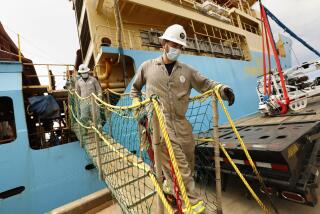Treasure Hunts Leave Their Mark : Florida: Underwater explosions, known as ‘mailboxing,’ are coming under renewed scrutiny because of the damage they can cause to the delicate sea grass, coral, fish- spawning ecosystem.
- Share via
ABOARD THE ENDEAVOUR — It’s 9 a.m. on a Friday and treasure hunter John Brandon leans over a small table on his 40-foot boat, blue pencil in hand.
Laid out before him on a crinkled map are hundreds of blue spots--some close together, some spaced apart--that look like a child’s unfinished game of connect-the-dots.
The map is a compilation of all the holes Brandon and his associates have blown into the ocean floor off Florida’s Treasure Coast in the last four years searching for treasure. The map is almost solid blue in some places.
“Sometimes we do 40 to 50 holes in a day,” Brandon says as he charts the next crater to be dug.
He fires up the engines. For about 15 minutes, the sound of thunder rumbles from beneath the swells. Milky white sand gurgles to the surface as the ship’s propulsion is deflected downward, gouging holes in the ocean floor.
Some 200 miles to the south, in the Florida Keys, this practice--known as “mailboxing”--is coming under renewed scrutiny because of the damage it can cause to the delicate underwater ecosystem.
Rules that would ban mailboxing in certain areas of the Keys have rocked an already uneasy relationship among environmentalists, federal officials and salvors, who have adopted angry anti-government rhetoric.
“Over-environmentalism, I call it,” said Mel Fisher, a prominent salvor who invented mailboxing but is banned by an injunction from using the technique in the Keys.
“We’re talking about living-room size holes being blasted into the ocean floor,” said Debra Harrison, Keys coordinator for the Wilderness Society, which is pushing for a ban on mailboxing in areas near coral or sea grass beds where fish spawn.
It’s early yet in the 1995 Atlantic diving season, and Brandon has returned to a site off Sebastian where he has had success before “to put coins in the bank.”
He has anchored his boat, the Endeavour, less than a mile offshore and has lowered into position under the boat the mailboxes, two R-shaped smokestacks about 3 feet around and 12 feet long. They look more like funnels than mailboxes.
When the ship’s engine is on, the boat’s powerful propulsion is deflected downward through the pipes which are attached to the propellers.
The “dusting” can clear a hole 10 feet deep and 30 feet wide, giving divers access to the ocean bottom where gold bars and silver coins have settled over hundreds of years.
Along Florida’s Treasure Coast, where the rough surf constantly changes the sea bottom, there is little or no coral growth and the craters are filled in quickly with sand, salvors say. The surf is so powerful that coins from a fleet of Spanish galleons that sank in 1715 routinely wash up on shore after big storms.
But in the calm, clear waters surrounding the Keys, the holes can remain unfilled for years, environmentalists say. They helped urge Congress to designate about 2,800 square miles of coastline extending from Key Largo to the Dry Tortugas as the Florida Keys National Marine Sanctuary in 1991.
A new draft plan for managing the Keys sanctuary would prohibit any salvaging in areas near coral reefs or on sea grass beds. It would require salvors to comply with tighter regulations than the state imposes in other areas.
In addition, wrecks found in the sanctuary would be considered historic cultural resources, a term that essentially grants ownership to the federal government. Salvors would have to turn over to the government up to 50% of their annual haul rather than the 20% they’re required to give the state from treasure found outside the sanctuary.
Divers, who also have a say in the debate, are worried that the restrictions may seal some wrecks off to them. In general, the recreational diving community wants access to wrecks but doesn’t want salvors to damage them, says Michael Gower, president of the Underwater Society of America, a San Francisco-based diving organization.
More to Read
Sign up for Essential California
The most important California stories and recommendations in your inbox every morning.
You may occasionally receive promotional content from the Los Angeles Times.












